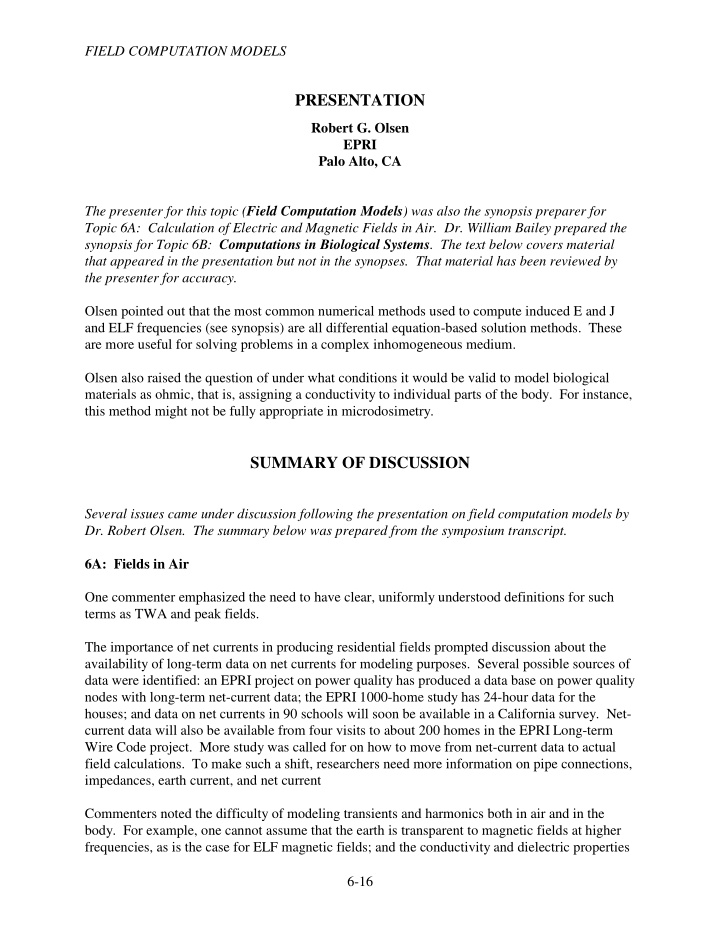



FIELD COMPUTATION MODELS PRESENTATION Robert G. Olsen EPRI Palo Alto, CA The presenter for this topic ( Field Computation Models ) was also the synopsis preparer for Topic 6A: Calculation of Electric and Magnetic Fields in Air. Dr. William Bailey prepared the synopsis for Topic 6B: Computations in Biological Systems . The text below covers material that appeared in the presentation but not in the synopses. That material has been reviewed by the presenter for accuracy. Olsen pointed out that the most common numerical methods used to compute induced E and J and ELF frequencies (see synopsis) are all differential equation-based solution methods. These are more useful for solving problems in a complex inhomogeneous medium. Olsen also raised the question of under what conditions it would be valid to model biological materials as ohmic, that is, assigning a conductivity to individual parts of the body. For instance, this method might not be fully appropriate in microdosimetry. SUMMARY OF DISCUSSION Several issues came under discussion following the presentation on field computation models by Dr. Robert Olsen. The summary below was prepared from the symposium transcript. 6A: Fields in Air One commenter emphasized the need to have clear, uniformly understood definitions for such terms as TWA and peak fields. The importance of net currents in producing residential fields prompted discussion about the availability of long-term data on net currents for modeling purposes. Several possible sources of data were identified: an EPRI project on power quality has produced a data base on power quality nodes with long-term net-current data; the EPRI 1000-home study has 24-hour data for the houses; and data on net currents in 90 schools will soon be available in a California survey. Net- current data will also be available from four visits to about 200 homes in the EPRI Long-term Wire Code project. More study was called for on how to move from net-current data to actual field calculations. To make such a shift, researchers need more information on pipe connections, impedances, earth current, and net current Commenters noted the difficulty of modeling transients and harmonics both in air and in the body. For example, one cannot assume that the earth is transparent to magnetic fields at higher frequencies, as is the case for ELF magnetic fields; and the conductivity and dielectric properties 6-16
FIELD COMPUTATION MODELS of an inhomogeneous human body are not easily modeled for transients and harmonics. Olsen noted that one of the most problematic things for calculating currents at higher frequencies is the presence of the grounding system. Discussants suggested that calculations are a proper method to evaluate new or modified lines, and to model historic exposure. However, there is currently too much inaccuracy, particularly in the models used in epidemiological assessments, to accept results without careful scrutiny. For example, using only calculated fields as an estimate of exposure implies that fields from local sources such as appliances are not important. This may or may not be justified. Given sufficient information, calculations are perhaps most appropriate for historical field reconstruction. However, Olsen emphasized that field models should be verified with contemporary measurements. Some felt that more experience and study were needed for complex conductor calculations. However, others felt that calculation methods are fairly straightforward for electric fields, as well as for magnetic fields if currents are known. Olsen stressed the need to do an assessment of calculations versus measurements on a case-by-case basis. He also indicated the usefulness of having the statistical distributions for currents in characterizing field variability. 6B: Fields in Biological Systems It was noted that, for calculations of induced currents in subjects when both electric and magnetic fields are present, it is very important to know the phase between the electric and magnetic fields. The comment was made that complex induction models of the human body can be applied to current and field distributions from contact currents as well as from external fields. This is important because the effects data used for setting guidelines are often based on extrapolations of internal fields and currents from contact currents. In response to a question raised in the presentation and synopsis, discussants agreed that there appears to be enough information on modeling techniques and contact currents for guideline- setting bodies to use more sophisticated computational models in computing induced current levels from applied fields. Dr. Thomas Tenforde, a member of the International Commission on Non-Ionizing Radiation Protection, reported that they are now taking such information into consideration. Newer mathematical modeling techniques take into account inhomogeneity in conductivity in the body and model currents within specific organs. They reveal the existence of higher currents in some areas than might have been expected based on simple models. Commenters also noted that existing models do not extend down to microdosimetry: we have progressed from cells as spheres to elongated cells, gap junctions, and other refinements, with the latter areas involving far less certainty than the simple models. However, at the internal body level and organ level, there remain numerous questions (no one has put a probe inside a person). 6-17
FIELD COMPUTATION MODELS Some discussion focused on measurement of currents within the body. Validation measurements for model calculations in localized areas are extremely difficult, and do not appear to be likely in the near future. 6-18
Recommend
More recommend